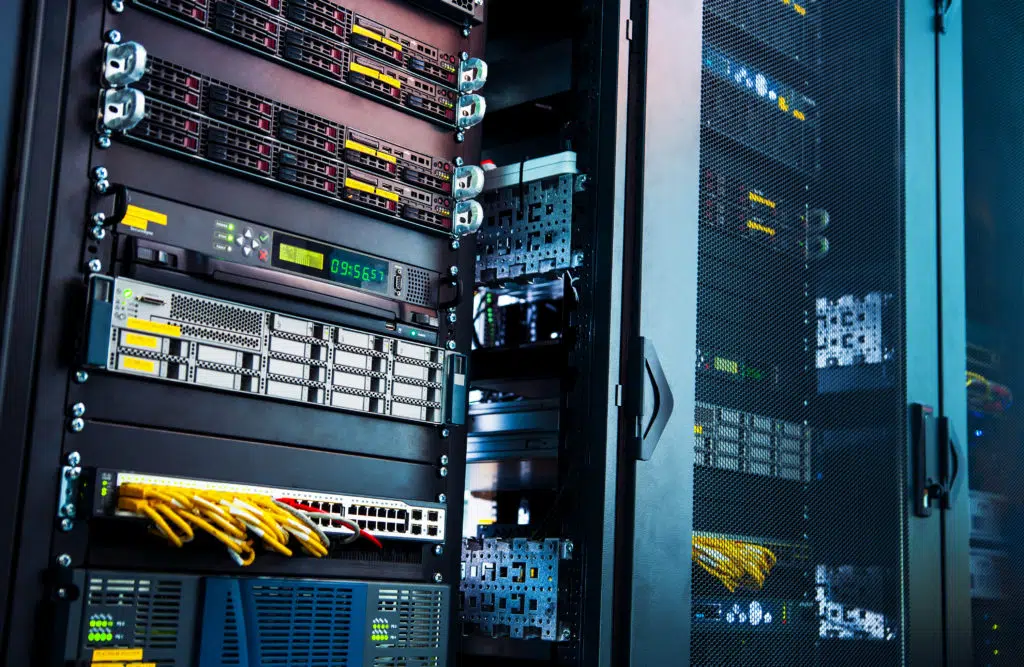Here’s everything about the difference between IT architecture and IT infrastructure:
A system’s IT infrastructure is the set of components, while its IT architecture is how they work together.
Simply put, a system is built on top of an IT infrastructure that has a specific IT architecture.
So if you want to learn all about how IT architecture and IT infrastructure differ from each other, then you’re in the right place.
Let’s jump right in!

What Is the Difference Between IT Architecture and IT Infrastructure?
While many people understand the basic practices behind information technology in this tech-savvy age, the actual terms we use are a different story.
While articles like architecture and infrastructure are relatively straightforward, could you explain the difference between IT architecture and IT infrastructure if you were asked?
In this article, we’ll get you started by explaining some of the differences between IT architecture vs. IT infrastructure.
Once you feel like you’re well-informed, you can even impress your friends and colleagues with your new knowledge.
IT Architecture & IT Infrastructure 101
If you saw “IT architecture vs. IT infrastructure” and immediately drew a blank, you might benefit from a little more background on these concepts.
First, you might know this already, but IT stands for information technology.
The definition of information technology is extensive.
Today, IT can mean any use of computers to manipulate, archive, send, or receive data. However, the term “IT” is usually used in context with business technology, not personal.
For example, if you have a computer, you send and receive data every day, but it’s not necessarily considered IT unless it’s your job to do so.
As you might expect, we’ll be throwing around the word “business” and lots of other business terms in this article.
Of course, all of these concepts can be applied to non-business settings quite successfully, but you should know that this is the context they most often work in.
IT Architecture vs. Infrastructure—a Quick Look
We’ll delve much deeper into what IT architecture vs. IT infrastructure means throughout this article, but we’ll give you a quick metaphor here to help speed things along.
IT architecture is like the “road map” to a business’s IT aspects—i.e., what needs to be done to satisfy the corporation’s IT needs.
All in all, it’s like a design or a plan.
IT infrastructure, on the other hand, is the assets themselves that are used.
For example, the following are some examples of assets that can work in IT infrastructure:
- Hard disk drives
- Network switches
- Routers
- Fiber optic cables
- Servers
- Computers
Broken down to its most essential parts, IT architecture is an idea, while IT infrastructure is the reality: the physical pieces that make up the IT system (and the IT system itself on a macroscopic level).
What Is IT Architecture?

If you used one word to describe IT architecture, it would be “design.”
While this isn’t a perfect translation for IT architecture, it’s the closest we can get without delving deep into IT systems and such.
However, if we want a proper understanding of just what information technology architecture is, we’ll have to dig a bit beyond just the surface terms.
After all, IT architecture is an emerging field with requirements that become more sophisticated every year.
In reality, information architecture isn’t just the design of an IT system.
While this is what the name suggests, it goes much deeper than that.
IT architecture considers things like the information assets of the parent business, the resources available, and known best practices in the industry.
Think of what architecture means from a normal perspective. It’s not just the physical design.
Instead, a good architect considers things like what a specific building can support, where you plan to build it, what weather effects it might be exposed to, and what the client needs rather than merely making whatever their heart desires.
Maps and Webs
Another way to think of IT architecture to put this in perspective a bit more is a map or a web.
Before concluding what IT technologies to deploy for an organization (we’ll look at this more under IT infrastructure), you need to consider all of the “information assets” of the business.
These informational assets can vary widely.
Of course, industry best practices come into play, and these tend to grow and evolve naturally as technology progresses and as we learn new things.
However, you also have to consider things like the hardware you have to work with, the building’s size, how much traffic it needs to support, and more.
A good IT architecture plan takes into account just about every detail about the business involved, what it’s doing now, what its present demands are for information technology, and everything you know about its future plans, too.
For example, if a given firm only supports a small town, but it has imminent plans to expand into the next city, that plan should be incorporated into the IT architecture.
Similarly, suppose a business has plans to merge with another in the near future that already has good IT architecture. In that case, an extensive system may not be necessary in the first place.
What Makes “Good” IT Architecture
That being said, what does it mean to practice the best IT architecture practices?
When it comes to IT architecture vs. IT infrastructure, it all depends on the client’s demands.
No matter how well you do, if your finished product doesn’t satisfy what the client wants or needs, you’ve failed in the end.
And finally, one last thing that characterizes good IT architecture is flexibility.
As said before, an organization’s needs can change over time, even if they didn’t plan for those needs initially.
A good IT architecture plan should have room to make upgrades and changes as things grow and change.
What Is IT Infrastructure?

IT infrastructure, while similar to architecture, in theory, is very different in reality.
Rather than being an intangible plan or idea, IT infrastructure includes all of the actual physical components of an IT system.
However—and this might complicate things a bit—IT infrastructure doesn’t have to be tangible.
It can also include the software and network assets included in a given network.
However, it does include physical, tangible assets for the most part.
The only things that an IT infrastructure does not include are the following:
- Processes
- People
- Documentation
People, Processes, and Documentation
People, obviously, refers to the people operating the IT system.
While you generally need some measure of human input to make an IT system function, people are, somewhat surprisingly, not considered part of this system.
Processes, on the other hand, are not the programs themselves.
As said earlier, software and programs are considered part of the IT infrastructure.
However, a process would be what happens after you launch one of these programs.
These processes do not count as separate entities in the IT infrastructure plan.
As you’ve probably guessed, documentation includes any information or instructions that come with the system’s tangible or intangible aspects.
For example, if you decided to use a specific coding language to accomplish a task on your IT network, such as Python or Java, the documentation of that coding language would not be accounted for in the infrastructure.
The Purpose of IT Infrastructure
What’s the purpose of IT infrastructure?
After all, the infrastructure for any given IT system, at its most basic level, is the same: it involves a network made up of various pieces of hardware and software that work together to perform one or more IT-related tasks for (or as part of) a business.
Essentially, IT infrastructure works to ensure that everything is correct at the most basic level of an IT system.
If you’ve dealt with computers before, you know that they can be fickle and even downright infuriating at times.
By diagramming the IT infrastructure of a given organization, an IT professional can see how interconnected parts work together.
This is what makes an IT infrastructure similar to IT architecture, and it’s where some of the confusion between them stems from, too.
Both systems function like webs, after all, and work to diagram all of the aspects of an IT system.
However, an IT professional tasked with working with an IT infrastructure is responsible for ensuring every individual node and wire performs correctly (and plays nicely with all of the others).
Fixing Problems and Upgrading Technology

By looking at the IT infrastructure of a given organization, an IT professional can quickly spot issues that might be causing the organization trouble.
Alternatively, they can pinpoint areas where the network might benefit from a product or technology upgrade.
With technology evolving and changing as fast as it is, it’s incredibly important to have an IT infrastructure that’s flexible and easy to upgrade.
For example, if your organization has a system that’s dependent on a single significant piece of hardware, you’ll have to resort to taking down the entire network when it’s time to replace that piece.
However, if you build a network with backup hardware and alternative data routes—things that let the system keep running even if part of it is out of commission—your business can keep running and thriving even during the upgrade process.
After all, every day (and even every hour) that your business’s website down means potential lost revenue.
What Really Is the Difference Between IT Architecture & I Infrastructure?
We’ve already explained the fundamental difference between IT architecture vs. IT infrastructure to you throughout this article.
While architecture is more of a plan or idea, infrastructure covers the physical aspects of the IT setup itself.
However, the differences (and even similarities) between IT architecture and infrastructure go deeper than that.
While both terms are similar in that they encompass an entire organization’s network, they’re used for very different things and during very different times in the IT process.
Using IT Architecture
When would you use IT architecture, for example?
An IT professional would look at the architecture of an IT system during initial planning systems—i.e. when a new network is planned and built.
Alternatively, if an existing business network needs a total overhaul, they might reference the IT architecture at that time, too.
Using IT Infrastructure
However, a network professional would reference the IT infrastructure of a system much more often, such as:
- When doing maintenance on the network
- When upgrading parts of the network
- When diagnosing issues with the network
- When expanding or downsizing the network
- Anytime the network and its components are accessed or changed
Similarities Between IT Architecture & IT Infrastructure
One of the main aspects that make IT architecture and IT infrastructure similar is their flexibility.
The ability to grow, adapt to changing technologies, expand with business conditions, and otherwise evolve is crucial for business networks.
Not only is it essential to keep your business network in tip-top shape for the sake of your customers, but it’s vital for the sake of any employees you might have, too.
A functional, dependable, modern, and easy-to-use network means happy and productive employees.
Of course, if you have any web or online store presence, a flexible network is crucial for the sake of your profits, too.
If your store is offline when a customer wants to purchase a product, they’ll likely look somewhere else to buy it.
That means lost revenue for you.
IT architecture is flexible in its own unique way.
Most IT architecture plans are designed to be flexible in this day and age, though no single strategy is perfect.
With how quickly technology develops, there’s no surefire way to know what will be different five years down the line and what will be the same.
IT infrastructure, on the other hand, should be flexible in a very straightforward way.
You should be able to upgrade your network or otherwise tweak it without completely disabling it or making it otherwise unusable.
This customizability is what makes IT infrastructure genuinely flexible.
Network Flexibility in Action
The idea of network flexibility is all well and good, but what does it look like in action?
One good (and easy to visualize) example is the network topology of a small business.
If you only had a few computers on your business network, for example, you might decide to set up a linear network topology.
In this setup, all of the computers and devices are connected to a single cable or line.
A linear setup is the simplest and cheapest option, but it also means that the structure can no longer send or receive data if one part of it becomes inoperable.
A “star” configuration, on the other hand, where every part of the network is connected to each other part of the network, is the most complicated, but it’s also the most dependable.
With this configuration, the network will continue to function no matter how many parts of it stop working.
For most businesses, a solution somewhere between the two is the most effective.
The goal is to balance complexity and price with the stability and flexibility that best suits your network’s needs.
IT Architecture vs. IT Infrastructure at Work
What do IT architecture and IT infrastructure look like in real life?
Well, for anyone who’s not an IT professional, the best example you can use to represent these concepts is the world wide web.
Everything connected to the internet, from the most massive servers down to the router you might have at home or at work, is part of this worldwide network.
The IT architecture for the world wide web was first thought of by Tim Berners-Lee, the man who invented it.
He wrote the first web browser to ever exist, and he envisioned a globally-linked information system for people to share to everyone’s benefit.
Tim’s vision of the world wide web was much more straightforward than what we have today, but that’s part of dealing with technology—we’re rarely able to conceptualize (or even imagine) how technology will grow and change a decade from now.
The World Wide Network
The IT infrastructure of the world wide web is all of the devices that connect to it.
Your smartphone, computer, cable modem, smart appliances, and much more are all part of the world’s IT infrastructure.
However, those are just the very peripherals of the world wide web.
At its core, the web is powered by hundreds of thousands of interconnected networks.
The Wi-Fi and every device in your home that’s connected to it, for example, make up a network.
However, the entire USA also has its own nationwide network, as does each state, city, and even individual building.
The bigger and more connected a network is, the more flexible it is, and the easier it is to grow.
For example, in a home environment, if your Wi-Fi stops working, your internet-dependent devices may no longer function until it’s fixed.
Local Outages vs. World Wide Outages
If just one server in an entire state goes down, the others will be able to pick up the excess and route traffic around the outage until that server becomes operable again.
IT architecture and IT infrastructure aren’t all that different when it comes to these networks.
Both terms conceptualize the makeup and function of one, especially in a business setting, though they do so in different ways.
While the terms IT architecture and IT infrastructure aren’t interchangeable (and you shouldn’t use them as such), their purpose, at its most basic level, is the same: to draw the full potential out of a given network environment, whether the worldwide network or on a smaller scale.
What Is an IT Architecture Review?
An IT architecture review is perhaps the most critical step in keeping your company’s valuable data safe from malicious entities.
Understanding what IT architecture is and how to review your setup is pivotal, not only to keep your business running smoothly but also to remain in compliance as you store your customer’s data.
So if you want to know all about IT architecture review, then this article is for you: How to do an IT architecture review?

